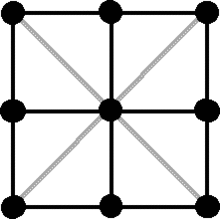Młynek (game)

Młynek (Polish: "little mill") or Mlýnek (Czech) is a two-player abstract strategy board game. It is also known as Grinder. It is unknown where the game originates from, or how old it is. Due to the simplicity of the board and rules, similar games can be found in many areas of the world from various historical periods. The board, shown on the right, is similar in design to that of either a Tic-tac-toe board (with the gray lines omitted) or an Achi board (with the gray lines included), and either such board can be used. The board is a 3x3 square grid, with 3 pieces for each player placed during the first phase of the game. On each move in the second phase, you move a piece along an edge of the grid. The goal is to block your opponent so that they have no such move. The first player to succeed at this goal wins the game.
Mlýnek is thus an abstract strategy game of the blockade family which include Mū Tōrere, Pong Hau K'i, Umul Gonu, and Pat Gonu.[1][2]
Goal
The player who blocks their opponent's pieces from moving is the winner.
Equipment
There are two board variations. Both are 3x3 square grids. One variant is simpler, with only orthogonal lines connecting the adjacent intersection points of the board. The other variant has left and right diagonal lines that connect the opposite corners of the board.
Each player has three pieces. One player plays the black pieces, and the other plays the white pieces.
Rules and Game Play
1. The board is empty in the beginning.
2. Players decide what colors to play, and who will start first.
3. Drop phase: Each player drops one piece per turn onto any vacant spot on the board (the circular dots shown in the board above). Players alternate their turns. Pieces cannot move until all three pieces have been dropped.
4. Move phase: After each player's three pieces have been dropped on the board, each piece can move one space at a time, either orthogonally (along the edges shown in black on the board above) or diagonally (along the edges shown in gray above). Only one piece can be moved per turn.
5. If a player, during the "Move phase", is unable to make a move, they lose the game.
References
- ↑ Podrȯże w krainie gier - Page 41 Lech Pijanowski - 1969 "Jak we wszystkie dobre gry, w młynek wygrywa się przecież nie tylko na planszy, lecz także w walce z określonym ... „nine-pin-miracle" — „cud dziewięciu pionków"), najbardziej jednak znana jest jako „nine men's morris", co by na język polski ..."
- ↑ Elet és tudomány - Volume 37 - Page 1146 1982 "Igen sok országban éppen úgy malom, ill. az ennek megfelelő szó, mint nálunk: mlynek (cseh), mlynek (lengyel), Mühle ... Érdekességként megemlítem, hogy az angolban nine-men's morris .kilenc ember fantasztikus tánca', a franciában les ..."